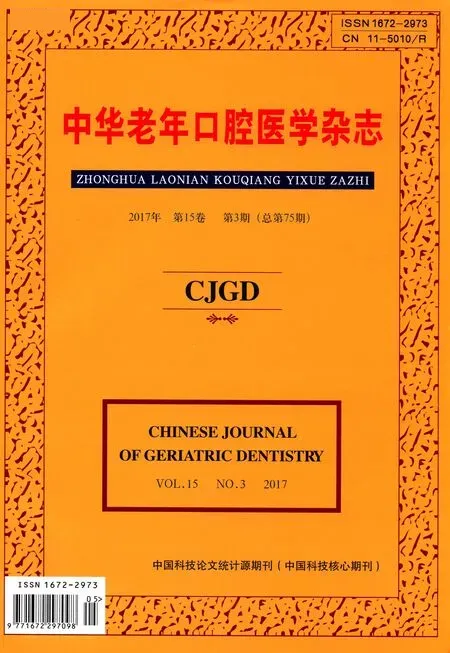牙周炎病史和维护情况对种植修复预后的影响*
2017-01-12谢也斯徐宝华
谢也斯 乔 敏 徐宝华
牙周炎病史和维护情况对种植修复预后的影响*
谢也斯 乔 敏 徐宝华
随着牙种植术和骨再生技术的广泛开展,种植修复已成为牙周炎患者缺牙修复的重要方式之一。同时,牙周炎患者种植体周围病的发生发展也日益为人们所关注。本文就近年来有关牙周炎病史和维护情况与种植体周围病发生相关性的研究进行综述,旨在帮助临床医师进一步认识种植体周围病与牙周疾病的关系,对种植体周围病的易感患者进行重点监测,预防疾病的发生,保障种植修复体的长期疗效。
种植体周围病;危险因素;牙周炎;规律维护
种植体周围病,作为一类常见的种植体生物学并发症,是指发生在种植体周围软硬组织的炎症感染性疾病,包括仅累及种植体周围软组织的可逆的种植体周围黏膜炎和同时累及种植体周围软硬组织的种植体周围炎[1]。近期一篇关于种植体周围病流行病学的系统综述[2]对2014年3月之前发表的相关文献进行meta分析,结果显示:种植体周围黏膜炎的发病率约为43%(95%CI:32-54%),而种植体周围炎的发病率约为22%(95%CI:14-30%)。种植体周围病发生率高,已成为全球负担[2],且种植体周围炎一旦发生,治疗难度大,短期治疗效果尚可,但长期研究显示,目前尚无有效的治疗方法阻止种植体周围炎的进展或复发,如炎症不能得到控制,则种植体将发生持续性骨吸收,最终导致种植失败[3]。因此,探索种植体周围病的危险因素,预防种植体周围病的发生,对保证种植修复的长期疗效起着至关重要的作用。
随着牙种植术和骨再生技术的广泛开展,种植修复已成为牙周炎患者缺牙修复的重要方式之一。同时,牙周炎患者种植体周围病的发生发展也逐渐为人们所关注。近年来探讨不同牙周状况和维护情况与种植体周围病相关性的研究增多,本文希望针对牙周炎病史和维护情况对种植体周围软硬组织健康状况的影响做一全面的综述。
1.牙周炎病史
牙周炎病史是种植体周围病的重要危险因素之一。国际上数篇系统综述[4-8]报道,相比牙周健康者,有牙周炎病史的患者种植体长期预后(≥5年)较差,种植体边缘骨丧失量更大,种植体周围炎发生率更高。此外,欧洲牙周病学研讨会、国际口腔种植学会、美国牙周病学会、欧洲骨结合协会等从08年至15年均陆续发表共识报告或声明,提出牙周炎病史与种植体周围疾病的发生率呈明显的正相关[9-12]。
牙周炎的严重程度影响种植体周围病的发生率。随着牙周炎患者种植治疗预后相关研究的深入,人们开始关注牙周炎的严重程度对种植体周围软硬组织健康状况的影响。近10年来有5篇前瞻性队列研究[13-17]根据实验对象牙周炎的严重程度进行分组,并对不同严重程度的牙周炎患者种植修复预后进行了评估。Gatti等人[13]根据改良的PSR (Periodontal Screening and Recording)指数对受试者进行分组,发现重度牙周炎和中度牙周炎组种植体骨吸收分别为2.57±1.06mm,2.72±0.44mm,明显高于无牙周炎组(1.24±1.09mm)(P<0.001),然而仅重度牙周炎组的4枚种植体患种植体周围炎,中度牙周炎和无牙周炎组均无患种植体周围炎的植体。Roccuzzo等系列研究[14-16]根据研究对象牙周情况进行分组,分组标准依据拟定的天然牙S指数:S=PD5-7mm的位点数+2*PD≥8mm的位点数,重度牙周炎患者S指数>25,中度牙周炎患者S指数≤25,其研究结果均显示,重度牙周炎患者的种植体骨吸收≥3mm的位点百分比明显高于牙周健康组(P<0.05)。Levin等人[17]根据1999年国际牙周研讨会上确定的分类将受试者分为重度牙周炎组、轻中度牙周炎组和无牙周炎组,研究发现重度牙周炎作为种植失败的一大危险因素,危险比达8.06(P<0.01)。由此可见,虽然各项研究中牙周炎分组标准的界定不尽相同,但均考虑到了牙周炎病情的广泛性及严重性(最深位点情况),结果均发现,随着牙周炎病情的加重,种植体边缘骨吸收增多、种植体周围炎发生率增高。
另外,牙周炎类型影响种植体周围病的发生率。Mengel等发表的数篇短期研究(3年)[18-20]显示,广泛型侵袭性牙周炎患者(Generalized Aggressive Periodontitis,GAgP)经过完善的牙周治疗后,其种植体边缘骨吸收程度与慢性牙周炎患者(Ch ronic Periodontitis,CP)及牙周健康者(Healthy Patient, HP)无明显差异。然而,该课题组发表的长期(>5年)前瞻性队列研究[21,22]表明:经完善牙周治疗的GAgP患者种植体周围骨吸收速率明显高于HP (P<0.05);且相比HP,GAgP患者种植失败的风险增高5倍,患种植体周围黏膜炎的风险增高3倍,患种植体周围炎的风险增高14倍。此外,De Boever等[23]也比较了HP(110例)、CP(68例)和GAgP (16例)种植修复的长期预后(平均随访时长48.1± 25.9月),结果显示GAgP患者种植体近远中边缘骨吸收速率均为0.17mm/年,明显高于CP(近中0.12mm/年,远中0.09mm/年)和HP(近中0.08mm/年,远中0.07mm/年)两组,且种植体存留率(84.75%)显著低于前两组(CP:96%;HP:98%)。Monje等[7]综述了近年来发表的有关GAgP和CP患者种植修复预后的临床研究文献,并进行meta分析,结果显示,种植体边缘骨吸收的加权均数差分别为:HP组-GAgP组=-0.28 mm (95%CI=-0.36--0.19mm),CP组-GAgP组= -0.43 mm(95%CI=-0.53--0.33mm)。且侵袭性牙周炎患者种植失败风险是慢性牙周炎患者的3.97倍,牙周健康者的4倍。由此可见,侵袭性牙周炎患者与慢性牙周炎患者、牙周健康者相比,种植体边缘骨吸收更多,种植体周围病发生的风险更高。究其原因可能是,侵袭性牙周炎患者存在一些不可改变的易感因素:(1)基因多态性;(2)免疫系统的异常(包括白细胞功能异常、巨噬细胞趋化功能异常等)等[7],而目前尚无证据表明天然牙被种植体取代后,宿主对微生物感染的反应会发生改变,因此牙周炎易感患者(侵袭性牙周炎患者)如感染控制不当,其种植体和天然牙发生骨丧失的危险性是相似的[24]。
值得注意的是,在上述所有涉及牙周炎病史与种植体周围病相关性的研究中,受试者均在进行积极牙周治疗及牙周状况控制良好的基础上,方行种植手术和种植修复治疗。然而部分患者,尤其重度牙周炎患者,在规范的牙周基础治疗,甚至进一步牙周手术治疗后,仍有残留的牙周深袋。那么,种植前余留牙周深袋是否会影响种植体周围病的发生率,目前仅有一篇回顾性研究对此进行了探讨。Pjetursson等[25]通过回顾70例有慢性牙周炎病史的种植患者种植前牙周状况,发现患种植体周围病者(诊断标准:种植体探诊深度≥5mm,探诊出血阳性),种植前天然牙余留深牙周袋(探诊深度≥5mm)百分比显著多于未患病者(4.1%±3.1%vs 1.9%±1.5%),因此,作者认为种植前余留的探诊深度≥5mm的牙周袋与种植体周围病的发生显著相关。
2.维护情况
2.1 种植体维护情况 2007年Hultin等[26]最早对种植体维护治疗与种植体长期预后(10年)的相关性进行了系统综述,并提出种植体维护治疗有助于预防种植体周围疾病的发生,然而因相关研究证据过少,不足以对种植维护频率提出科学合理的建议。随着这方面研究的增多,Monje等[27]检索了2015年6月以前Cochrane对照试验中心注册库、荷兰医学文摘数据库和美国医学索引等多个数据库上已发表的有关种植体维护的文献,并进行meta分析,结果显示,种植体维护治疗的频率对种植体周围黏膜炎及种植体周围炎的发生率有显著影响。作者提出完善的种植治疗不应仅局限于种植体的植入及修复,而应该继续贯彻至种植体周围组织的定期维护中,从而减少生物学并发症的发生、增加种植体长期成功率,并建议种植体的复查间隔不应超过5-6个月。此外,Costa等[28]对80名种植体周围黏膜炎的患者进行5年纵向观察,发现已发生黏膜炎的种植体,若未进行定期维护,5年后其发展成为种植体周围炎的风险将从18.0%增至43.9% (OR值=5.92)。
2.2 牙周维护情况 有关牙周维护治疗与种植体周围软硬组织健康状况的短期及长期研究均表明,牙周维护治疗有利于种植体周围软硬组织的短期及长期健康。一篇1年的短期研究对49例慢性牙周炎患者246枚Astra种植体根据其是否遵医嘱定期牙周维护(SPT)进行分组,分为SPT组和非SPT组,比较两组边缘骨吸收程度。结果显示,非SPT组种植体近远中平均骨吸收为(0.62±0.94)mm,明显高于SPT组[(0.16±0.15)mm](P<0.001)[29]。目前为止,仅有的几篇涉及牙周炎患者定期维护对种植体预后影响的长期纵向研究中,对牙周维护的分组方式各不相同。其中仅Roccuzzo等人[14,15]的研究分组标准较为严格,视患者具体情况制定个性化的牙周维护,根据患者是否遵医嘱维护进行分组。结果显示,在平均10年的观察期内,无论轻中度牙周炎患者还是重度牙周炎患者,遵医嘱维护组种植体周围探诊深度≥6mm的位点百分数均显著低于未遵医嘱维护组(轻中度牙周炎:4.8%vs 42.3%:P=0.001;重度牙周炎:21.7%vs 58.3%:P=0.01),遵医嘱维护组种植体存留率显著高于未遵医嘱维护组(轻中度牙周炎:96.2%vs 54.5%:P=0.005;重度牙周炎:89.7%vs42.9%:P=0.016),且轻中度牙周炎患者中遵医嘱维护组出现严重骨吸收(BL≥3mm)的植体百分比显著低于未遵医嘱维护组(11.5%vs 63.6%:P=0.003)。2014年Roccuzzo等[16]单纯针对SLA表面种植体进行了类似的研究,结果仍表明牙周炎组未遵从医嘱定期维护的患者种植体周围炎患病率更高。Pjetursson等[25]根据患者在伯尔尼大学定期维护或私人诊所维护进行分组,结果发现在大学进行规律维护的患者种植体周围炎的发病率更低,但无统计学差异(P>0.05)。除根据维护情况进行分组外,Lee等[30]的研究根据5年维护期内,复查时天然牙是否存在PD≥6mm牙周袋进行分组,将牙周炎患者分为“有余留牙周袋”(residual pockets,RP)和“无余留牙周袋”(no residual pockets,NRP)两个亚组,结果发现,RP组种植体探诊深度、骨吸收程度及种植体周围炎发病率明显高于NRP组及牙周健康者。因此,有牙周炎病史的患者,种植后未进行定期牙周维护和牙周炎症的复发或恶化,是种植体周围病的重要危险因素。
综上所述,尽管不同研究的异质性较大,但研究均表明,种植患者,尤其是有牙周炎病史的患者,种植修复后定期的种植体和牙周维护是保证种植体远期疗效的关键。在临床上,针对不同的患者,应通过其危险因素的评估,确定合适的维护间隔和方案。今后也还需要更多的纵向研究关注不同牙周状况患者的不同维护频率及牙周炎控制情况对种植体预后的影响。
[1] Zitzmann N U,Berglundh T.Definition and prevalence of peri-implant diseases[J].J Clin Periodontol,2008,35(8Suppl): 286-291
[2] Derks J,Tomasi C.Pecri-implant health and disease.A sys-tem atic review of current epidem iology[J].J Clin Periodontol,2015,42 Suppl 16:S158-S171
[3] Heitz-May field L J,Mombelli A.The therapy of peri-implantitis:a systematic review[J].Int J Oral Maxillofac Implants,2014,29 Suppl:325-345
[4] Pesce P,Menini M,Tealdo T,et al.Peri-im plantitis:a system atic review of recently published papers[J].Int J Prosthodont,2014,27(1):15-25
[5] Stacchi C,Berton F,Perinetti G,et al.Risk Factors for Peri-Imp lantitis:Effect of H istory of Periodontal Disease and Smok ing Habits.A Systematic Review and Meta-Analysis [J].J Oral Max illofac Res,2016 Sep 9,7(3):e3
[6] Renvert S,Persson G R.Periodontitis as a potential risk factor for peri-im plantitis[J].J Clin Periodontol,2009,36 Suppl 10:9-14
[7]Monje A,A lcoforado G,Padial-Molina M,et al.Generalized aggressive periodontitis as a risk factor for dental im plant failure:a systematic review and meta-analysis[J].J Periodontol,2014,85(10):1398-1407
[8] Sousa V,Mardas N,Farias B,et al.A system atic review of im plant outcomes in treated periodontitis patients[J].Clin Oral Implants Res,2015
[9] Heitz-May field L J,Huynh-Ba G.History of treated periodontitis and smok ing as risks for im plant therapy[J].Int J Oral Max illofac Implants,2009,24 Suppl:39-68
[10]Lindhe J,Mey le J.Peri-implant diseases:Consensus Report of the Six th European W orkshop on Periodontology[J].J Clin Periodontol,2008,35(8 Suppl):282-285
[11]Peri-im plant mucositis and peri-implantitis:a current understanding of their diagnoses and clinical im plications[J].J Periodontol,2013,84(4):436-443
[12]Renvert S,Quirynen M.Risk indicators for peri-im plantitis. A narrative review[J].Clin Oral Implants Res,2015,26 Suppl 11:15-44
[13]Gatti C,Gatti F,Chiapasco M,et al.Outcome of dental implants in partially edentulous patients w ith and w ithout a history of periodontitis:a 5-year interim analysis of a cohort study[J].Eur J Oral Im plantol,2008,1(1):45-51
[14]Roccuzzo M,Bonino F,Ag lietta M,et al.Ten-year resu lts of a th ree arms p rospective cohort study on im plants in periodontally comprom ised patients.Part 2:clinical results[J]. Clin Oral Imp lants Res,2012,23(4):389-395
[15]Roccuzzo M,De Angelis N,Bonino L,et al.Ten-year resu lts of a th ree-arm prospective cohort study on im plants in periodontally com prom ised patients.Part 1:im plant loss and radiographic bone loss[J].Clin Oral Im plants Res,2010,21 (5):490-496
[16]Roccuzzo M,Bonino L,Dalm asso P,et al.Long-term resu lts of a th ree arm s p rospective cohort study on implants in periodontally com prom ised patients:10-year data around sandb lasted and acid-etched(SLA)surface[J].Clin Oral Imp lants Res,2014,25(10):1105-1112
[17]Levin L,Ofec R,Grossmann Y,et al.Periodontal disease as a risk for dental implant failure over time:a long-term historical cohort study[J].J Clin Periodontol,2011,38(8):732-737
[18]Mengel R,Flores-De-Jacoby L.Implants in patients treated for generalized aggressive and ch ronic periodontitis:a 3-year prospective longitudinal study[J].J Periodontol,2005,76(4): 534-543
[19]Mengel R,Flores-De-Jacoby L.Im plants in regenerated bone in patients treated for generalized aggressive periodontitis:a prospective longitudinal study[J].Int J Periodontics Restorative Dent,2005,25(4):331-341
[20]Mengel R,K reuzer G,Lehmann K M,et al.A telescopic crow n concept for the restoration of partially edentulous patients w ith aggressive generalized periodontitis:a 3-year prospective longitudinal study[J].Int J Periodontics Restorative Dent,2007,27(3):231-239
[21]Mengel R,Beh le M,Flores-De-Jacoby L.Osseointegrated imp lants in subjects treated for generalized aggressive periodontitis:10-year results of a prospective,long-term cohort study[J].J Periodontol,2007,78(12):2229-2237
[22]Sw ierkot K,Lottholz P,Flores-De-Jacoby L,et al.Mucositis,peri-im plantitis,implant success,and survival of imp lants in patients w ith treated generalized aggressive periodontitis:3-to 16-year results of a prospective long-term cohort study[J].J Periodontol,2012,83(10):1213-1225
[23]De Boever A L,Quirynen M,Coucke W,et al.Clinical and radiographic study of im plant treatment outcom e in periodontally suscep tib leand non-susceptib lepatients:a prospective long-term study[J].Clin Oral Im plants Res,2009,20 (12):1341-1350
[24]孟焕新.牙周炎患者种植治疗的临床策略[J].中华老年口腔医学杂志,2013,11(1):54
[25]Pjetursson B E,Helb ling C,W eber H P,et al.Peri-im plantitis susceptibility as it relates to periodontal therapy and supportive care[J].Clin Oral Im plants Res,2012,23(7):888-894 [26]Hu ltin M,Kom iyam a A,K linge B.Supportive therapy and the longevity of dental implants:a systematic review of the literature[J].Clin Oral Im plants Res,2007,18 Suppl 3:50-62 [27]Mon je A,A randa L,Diaz K T,et al.Im pact of Maintenance Therapy for the Prevention of Peri-im plant Diseases:A System atic Review and Meta-analysis[J].J Dent Res,2016,95: 372-379
[28]Costa F O,Takenaka-Martinez S,Cota L O,et al.Peri-implant disease in subjects w ith and w ithout preventive maintenance:a 5-year follow-up[J].J Clin Periodontol,2012,39 (2):173-181
[29]Aguirre-Zorzano L A,Vallejo-A isa F J,Estefania-Fresco R.Supportive periodontal therapy and periodontal biotype as prognostic factors in imp lants p laced in patients w ith a history of periodontitis[J].Med Oral Patol Oral Cir Bucal, 2013,18(5):e786-e792
[30]Cho-Yan L J,Mattheos N,Nixon K C,et al.Residual periodontal pockets are a risk indicator for peri-im plantitis in patients treated for periodontitis[J].Clin Oral Im plants Res, 2012,23(3):325-333
Influence of history of periodontitis and maintenanceon outcome of im plant therapy
XIE Ye-si,QIAOMin,XUBao-hua
(Center of Stomatology,China-Japan Friendship Hospital,Beijing 100029,China)
With the extensive development of dental implant and bone regeneration,implant therapy has become one of the most important methods of dental restoration in patients w ith periodontitis Meanwhile,attention is increasingly paid to the occurrence and development of peri-implant disease in patients w ith periodontitis.The aim of this review was to summarize the influence of a history of periodontitis and maintenance therapy on the outcome of implant therapy.The purpose of this study is to help clinicians to further understand the relationship between periodontal disease and periodontal disease,and to monitor the susceptibility of the patients w ith the disease.To prevent the occurrence of disease and protect the long-term effect of implant therapy.
peri-implant disease,risk factor,periodontitis,regular maintenance
[文献标识码]A [文章编号]1672-2973(2017)03-0000-00
2017- - )
国际科技合作与交流专项(项目编号:2014DFA31520)
谢也斯 卫生部中日友好医院口腔医学中心 住院医师北京 100029
乔 敏 卫生部中日友好医院口腔医学中心 主治医师北京 100029
徐宝华 通讯作者 卫生部中日友好医院口腔医学中心教授 北京 100029
